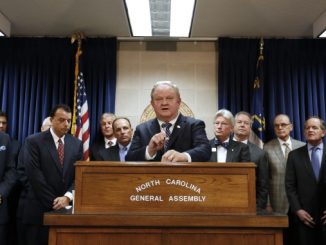

WASHINGTON, D.C. — The White House Situation Room — a space of great mystique and even greater secrecy — just got a $50 million facelift.
Actually, “room” is a misnomer. It’s a 5,500-square-foot, highly secure complex of conference rooms and offices on the ground floor of the West Wing.
These are rooms where history happens, where the president meets with national security officials to discuss secret operations and sensitive government matters, speaks with foreign leaders and works through major national security crises.
It’s where President Barack Obama and his team watched the raid that took down al-Qaida leader Osama bin Laden in 2011, where President Donald Trump monitored the 2019 operation that killed Islamic State leader Abu Bakr al-Baghdadi, and where President Lyndon Johnson went over Vietnam War plans.
The latest redo was no small update: The total gut renovation took a year to complete.
The White House opened the classified space to a group of reporters for a rare visit to check out the new look. President Joe Biden got a tour and then received an intelligence briefing in the space, said Marc Gustafson, the Situation Room director.
“He loved it. He thought the update was fantastic,” Gustafson said.
“Folks, the newly renovated White House Situation Room is up and running,” Biden said in a post on X. “My thanks to everyone who worked on this incredible facility.
The renovated space has a modern-but-vintage vibe. Old floors, furniture, computers and other tech were stripped out and replaced with pristine mahogany paneling from Maryland, stonework from a Virginia quarry, LED lights that can change colors and flat-screen panels. See-through glass offices fade to opaque with the press of a button. The whole space has that new car smell.
But there are still plenty of landline phones: No cellphones are allowed in the secure space for security reasons. (There are cubbies to stow phones near a door leading outside, where a baggie with some cocaine was found earlier this year.)
Access is tightly controlled and generally restricted to the president’s national security and military advisers. Anyone listening in on classified briefings needs clearance. Even the contractors working on the renovation had to get temporary security clearances. Illuminated signs flash green for declassified and red for classified.
The hush-hush complex was created in 1961 by the Kennedy administration after the Bay of Pigs invasion. President John F. Kennedy believed there should be a dedicated crisis management center where officials could coordinate intelligence faster and better.
That was an upgrade, to be sure. But it wasn’t exactly comfortable: Nixon administration national security adviser and then Secretary of State Henry Kissinger described the space as “uncomfortable, unaesthetic and essentially oppressive.”
After the Sept. 11, 2001, terrorist attacks, the White House did a significant Situation Room update, along with a broader upgrade to presidential communications on Air Force One and the presidential helicopter. Presidents used the complex for secure video conferences before such tech became more portable. The last renovation was in 2007.
The complex is staffed around the clock by military and civilian personnel who monitor breaking developments worldwide.
It has a reception area with a U.S. seal in stonework. Behind that is the main conference room, known as the “JFK room.” To the right are a smaller conference room and two soundproof “breakout rooms.” To the left is the “watch floor,” a 24-7 operations center.
“It’s a marriage of the traditional and the modern,” Gustafson said of the new space.
Workers dug 5 feet underground to make more room and install cutting-edge technology allowing White House officials to bring together intelligence from different agencies with the push of a few buttons.
“Now we have all the capabilities,” Gustafson said.
For those in the know, referring to the “sit room” is out. It’s the “whizzer,” stemming from the complex’s acronym: WHSR. (Washington does love a good acronym.)
Gustafson said the goal is to never need a complete renovation again. The new space was designed so panels can be removed and updated with new technology swapped in, usually with less space needs. A room once taken up by computer servers has become a smaller conference room.
While the area was closed for renovation, White House officials used other secure spots on the campus. Gustafson said the renovated Situation Room is having a soft opening of sorts: About 60% of the staff are back in the space with more coming every day.
One cosmetic upgrade Gustafson pointed out is the ability to swap out the different 2-foot-diameter seals that hang on the JFK room wall, depending on who is in the meeting. Seals for the president, vice president and executive staff are kept in a nearby closet and can be quickly subbed.
Gustafson said visitors previously remarked that the room didn’t reflect Hollywood’s grand imagining of the space.
He said they now declare: “This looks like the movies.”



